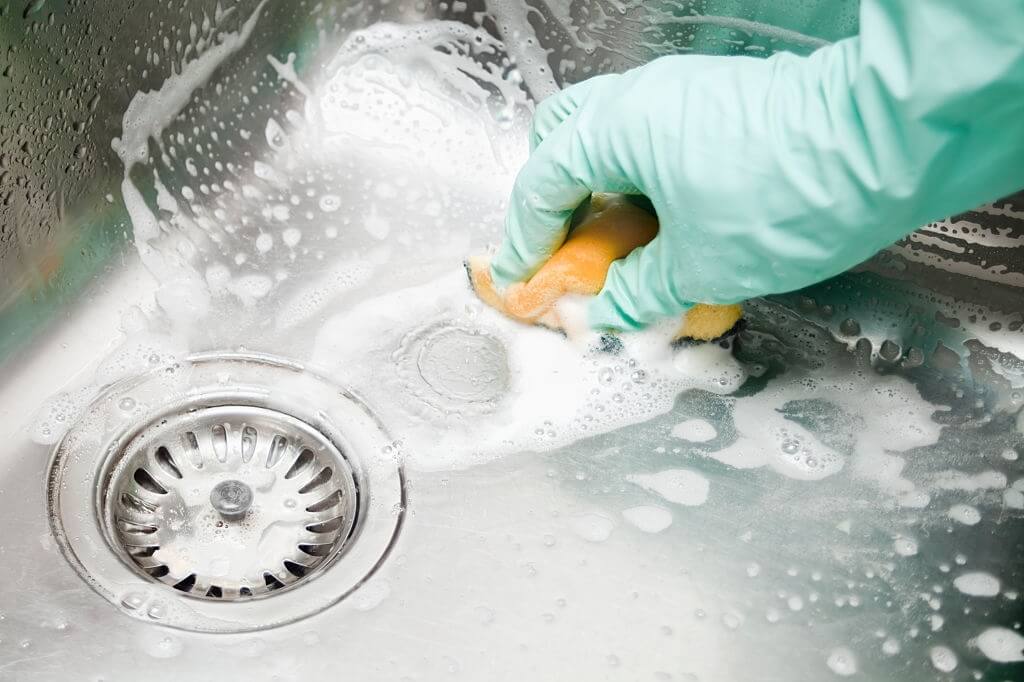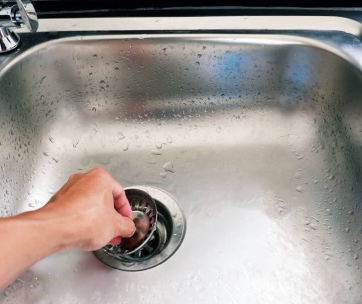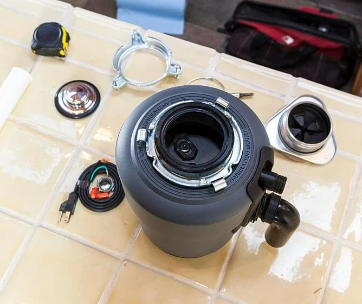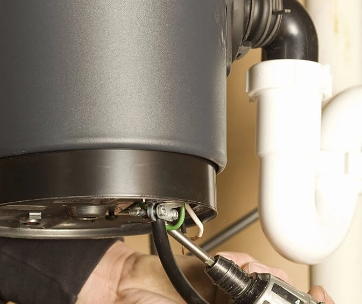The kitchen sink is one of the busiest places in your kitchen. Sink cleaning is very essential, and even though many people think that they clean their sinks right, they may be cleaning them less than they should!
Between your busy schedules within the week, it is easier for dishes to pile up in your kitchen sink or leave food material in the drain of your sink without running the disposal. It is understandable. However, the kitchen sink and drain deserve proper cleaning regularly to give your kitchen a fresh smell. If not careful, a natural buildup of dirt can occur in the drain resulting in a clogged sink and foul smell within your kitchen and house. The drain pipes may clog, resulting in flooding of the sink, and the surface of the sink may become stained. Furthermore, a sink that has not been properly cleaned may cause you and your family diseases. The good news is that all of these can be avoided by following six easy steps for cleaning the sink highlighted in this article. Before beginning the cleaning process of a sink like a pro, let us first understand how dirty your kitchen sink can be.
How Dirty is Your Kitchen Sink?
Most often, your kitchen sink looks neat to the eye, right? Well, it may be far from being clean. The sink is one of the places in the kitchen that harbor food particles, moisture, and hidden spots that form a perfect environment for the breeding of foodborne bacteria. Just like showers and bathtubs get residue buildup from cleaning our bodies, kitchen sinks also accumulate dirt from washing pans, plates, pots, and dishes. All the dirt that comes from the utensils creates a film of dirt on your sink, which acts as a perfect culture for micro-organisms that can cause disease and mold. Eating some of those micro-organisms and fungi would lead to stubborn stomach problems. Very risky, right? Here are some of the tips that you should consider when cleaning your kitchen sink and drain to keep your family safe from unwanted sicknesses as well as to give your kitchen the fresh smell that it deserves.
Cleaning the Kitchen Sink Like a Pro
What Do You Need?
A kitchen sink can be cleaned using a soft cloth or sponge and warm soapy water. However, if your sink sees a lot of use in a week, you will need additional cleaning resources including rubber gloves, baking soda, non-abrasive scrubber, lemon, white vinegar, salt, and hydrogen peroxide.
Step by Step Guide on How to Clean Your Kitchen Sink
Step 1: Empty the sink
Before starting the cleaning process, ensure that the sink is empty by removing everything including any utensils, dishes, pots, and dish racks. Give the sink a thorough rinse washing away any liquid, food, or debris before you start cleaning the kitchen sink. After rinsing the sink, clear the sink drains as well. This gives you sufficient space to conduct proper cleaning on your sink.
Step 2: Begin with the sink basin
If your sink is regularly cleaned, use mild dish soap and water to wet the sink basin. Soapy water, unlike other cleaners, is less reactive hence most appropriate for cleaning sinks. However, if the sink has not been washed in a while, consider sprinkling baking soda all over the sink basin.
Step 3: Scrub the sink basin using a sponge or a cloth
Once your sink is covered by soapy water or baking soda, use a clean sponge or cloth to scrub the surface of the basin sink effectively. A small amount of soap can be added to the cleaning sponge or cloth to facilitate the easy cleaning of oils. While baking soda is abrasive, it is not tough enough to leave scratches on stainless steel or other kinds of sink materials. Scrub the sink basin from top to bottom and toward the drain. It is recommended that you use a circular motion and be sure to scrub out the entire sink.
Step 4: Consider the handles, faucets, and difficult to reach spots
Using a clean wet sponge or cloth, wipe the faucet and handles. Using a wet sponge to wipe the faucets and handles and rinsing them with water gives them their like-new appearance. Remember that cleaning the faucet aerator is also essential. Click here for detailed guide on how to clean the faucet aerator.
Regarding the hard-to-reach spots in the faucets and handles, use a soft-bristled toothbrush applied with soapy water to scrub. Also, consider using the brush to scrub the nooks and crannies in the sink basin. If there are water stains and grime in the stainless steel, they can be removed by spraying water and white vinegar solution.
Does Your Faucet Contain Mineral Build-up?
In some areas, tap water contains minerals that can accumulate and build up in the faucet. You do not need to hire a contractor to unclog your faucets. You only require white vinegar and follow the steps provided.
After you have completed cleaning the sink and the drain, cover the faucet with a bag full of vinegar. Maintain the white vinegar inside the faucet for several hours (or you can let it stay there overnight). Then, scrub the deposits in the faucet using a soft bristle brush until it goes off.
Special considerations during deep cleaning
If the sink and drain have not been cleaned for a long time, they may require deep cleaning. Sinks are made from different materials including porcelain, granite, stainless steel, and other types of materials. Baking soda is the most recommended cleaning agent for all kinds of sinks that require deep cleaning to prevent scratching.
Sprinkle baking soda on the sink until it covers the sink surface, then use a wet cloth or sponge to scrub. Rinse with running water, preferably warm.
If you experience stubborn stains, you may be required to apply extra cleaning power.
For sinks made of porcelain, apply hydrogen peroxide on the sink to dissolve the tough stains. Allow a few minutes of fizzling before scrubbing until the stain is gone and rinsing with clean water.
For sinks made of stainless steel, apply vinegar on the grime and let it stay for a few minutes. Scrub with a soft cloth or sponge before rinsing with clean water.
For sinks made of material other than stainless steel or porcelain, add dish soap to the cloth or sponge and scrub until the stain fades.
Sanitizing the kitchen sink
After washing the kitchen sink effectively using the steps provided above, most of the germs are cleared. However, it is important to sanitize the sink to ensure that all harmful germs are cleared. White vinegar is the most recommended sanitizing agent for porcelain and stainless steel sinks.
The steps for sanitizing include first, mixing half water and half vinegar in a spray bottle. Second, spraying the solution on the sink and allowing it to stay for some minutes, and then finally washing the vinegar solution by rinsing the sink with water.
The Drain
The drain may contain food particles and other dirt. It is important to appropriately clean the drain to prevent foul smell in the house because of waste materials hidden in it. The gunk down the pipes can be cleaned using hot water, white vinegar, or baking soda.
Follow the following steps when cleaning the drain.
- Boil water.
- While the water is boiling, sprinkle sufficient baking soda on the drain.
- Add a cup of white vinegar down the drain.
- Leave the drain hole to stay for some minutes and cover it up.
- After a few minutes, pour the hot water down the drain hole to wash it out.
- If your pipes are made of plastic materials, wait for the water to slightly cool down before using to avoid damaging the piping system.
Following the highlighted steps will leave your sink and drain sparkling clean, and you will not have to worry about a foul smell coming from the sink or disease-causing microorganisms breeding in your sink. A precaution you should consider when using your sink is to avoid disposing of greasy food residue down the drain disposal. Grease can clog the drainage system easily - click here to learn how to unclog a kitchen sink - hence preventing the flow of other waste material. This would take a toll on the whole sewer system. Reducing the pouring of greasy waste into the sink, therefore, is the easiest way of avoiding overloading the sewer system and associated unclogging costs.
FINAL WORDS
Your kitchen sink and drain deserve to be shown some special love. Be sure to clean your sink and drain with our how-to instructions, and you will love your kitchen. It is important to add the plan for cleaning the kitchen sink and drain into your weekly cleaning routine to make it a habit. A healthy kitchen sink and drain are key to a healthy family. Keep your family healthy but maintaining the high-level cleanliness of your kitchen sink at all times. Be sure to use our resources to achieve the best-level sink cleanliness.









Comments